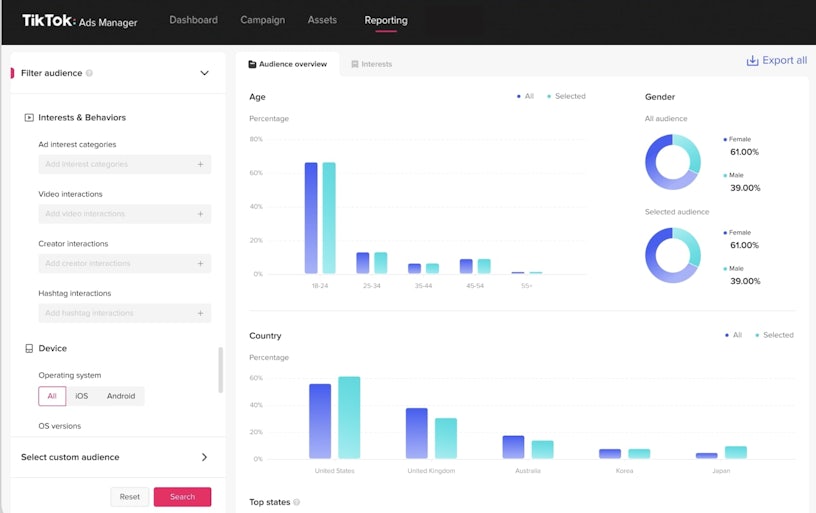With Christmas around the corner, we’ve released our final Paid Social Industry Updates blog of 2022! Pour yourself a glass of mulled wine, grab a mince pie and discover the latest social media trends to see you into the New Year:
As always, traffic light imagery is featured throughout to indicate the importance of each new update – red denoting a priority update, green representing a less important update, and amber lying somewhere in the middle.
Meta launches Multi-Advertiser Ads

Meta has introduced Multi-Advertiser Ads to the Instagram platform, which enables an ad to appear alongside other ads from similar businesses in the feed placement.
Leveraging Meta’s machine learning system, the new feature will display ads to users who are in a shopping mindset and have recently engaged with similar ad content.
The new feature can be activated at the ad level in Ads Manager, although delivery to the multi-advertiser format isn’t guaranteed – instead being determined by machine learning.

What Does This Mean For Me?
Meta’s latest feature will benefit ecommerce advertisers by showing their ads to users who are in a shopping mindset and who may find their content interesting. Crucially, by leveraging Meta’s machine learning to find these engaged users, this should have a positive impact on the number of purchases generated.

This has been backed up by early tests which show that, in campaigns optimised towards driving purchases, campaigns using multi-advertiser ads outperformed those without multi-advertiser ads.
However, it’s unclear what the impact on CPA or ROAS was during these tests. Would ads showing your brand alone in a full-screen format drive more purchases at a lower cost, compared to being included in a carousel of similar brands beneath another ad?
Another thing to consider is the lack of control associated with the type of ads your brand could appear next to. Whilst Meta offers various brand safety controls covering certain placements and publishers, there are currently no controls available to control the type of content your ad could be delivered next to. If you feel strongly about your ads appearing alongside certain content, this could be something to consider when deciding whether to launch Multi-advertiser ads.
Ready to trial Meta’s new ad format? Try split-testing multi-advertiser ads against the same ads without this new feature. Allow the ads to run for some time (you may want to leave this longer than usual as delivery to the format isn’t always guaranteed) and compare performance through the Instagram feed placement to determine which set-up drives the best performance for your business.
As the feature leverages machine learning, we advise providing Meta with enough data as possible to help it reach relevant users and maximise performance. If you aren’t already, consider uploading offline data from your CRM platform to provide Meta with some customer information, which can help the system find similar users. Conversions API can also provide Meta with more accurate conversion data, enabling the system to reach users who are more likely to find your ads relevant.
TikTok introduces audience insights

TikTok has launched a new tool to help marketers better understand their target audience on the social media platform. Sitting within the reporting dashboard on Ads Manager, Audience Insights provides various information about an audience – spanning their interests, demographics and behaviours.

What Does This Mean For Me?
One of the key benefits of TikTok’s latest tool is the ability to uncover your target audience’s key interests, which can provide inspiration for new campaign content. For example, if a retailer finds that their audience is interested in sustainability, their paid social ads could focus more heavily on their sustainable product lines. This could help to inform new ad copy variations and creative assets, leading to better ad engagement and an increase in purchase volume as a result.
Audience Insights could also be used to discover new audiences to target. If you review your target audience’s interests and uncover any surprising insights, you may want to consider targeting these interests to see how they perform. This may be particularly beneficial if you’re looking for new ways to scale your campaign, or if any current audiences are underperforming.
As always, we recommend split-testing any new ad variations or audiences against your current campaign set-up; reviewing performance after allowing the ads to run for some time.
Meta re-introduces attribution setting comparisons

After being removed for over a year, the ‘Compare Attribution’ feature has returned to Ads Manager, enabling advertisers to compare conversions over different attribution settings including:
- 1 day view
- 1 day click
- 7 day click
- 28 day click
To use the new tool, head to Ads Manager, click columns and then performance – you’ll see ‘compare attribution settings’ at the end of the columns menu. Then simply click it to select the attribution settings you want to view in your report.
What Does This Mean For Me?
The new feature will provide more flexibility for measuring the success of Paid Social activity, by enabling advertisers to compare conversions over different attribution windows for each campaign.
The 28 day click attribution setting will be particularly useful for those advertising high-involvement products, by enabling them to more accurately measure the success of a campaign, considering the longer consideration period before a conversion occurs.
The feature will also allow advertisers to understand how many conversions resulted from clicks or views. Click-through conversions may be more valuable to your business compared to view-through conversions, as the conversion occurs after a user has engaged with and clicked through your ad. View-through conversions are attributed even if no ad engagement takes place – which usually occurs when retargeting high-intent users who have previously interacted with your brand.
Ultimately, these new attribution tools will provide additional ways to measure campaign results, which could help marketers better understand the purchase journey for various products.
Meta releases new custom audience feature

Meta has released a new feature, enabling advertisers to create a custom audience from users who follow their Instagram account. To maintain the audience’s relevancy, Meta will automatically remove users from the audience if they unfollow the account.
The new feature is gradually being rolled out to all ad accounts. To check if you have access, create an Instagram custom audience and view the event dropdown options available.

What Does This Mean For Me?
Advertisers can currently create a custom audience from users who have ‘engaged’ with an Instagram account, having either visited the profile or taken action on a post or ad. However, the new update will enable advertisers to build an audience of their most engaged users who choose to receive regular updates from a business.
By targeting these engaged users, this could have key implications for converting followers into repeat customers, by using paid social ads to cross-sell and up-sell various product ranges. Paid social ads could also be leveraged to retain engaged users with exclusive discount codes, competitions and early access opportunities to increase customer lifetime value – which has a positive impact on revenue over time.
The new custom audience feature could also be leveraged to build a lookalike audience of similar users who may also engage with your business offering, enabling advertisers to scale their campaigns and reach new users who may also be profitable.
Finally, the new update could enable advertisers to exclude Instagram followers from prospecting campaigns, in order to align paid social activity more closely with the customer journey and create tailored content for different users, depending on where they are in the funnel.
Look out for our next blog post for more paid social industry updates to inspire your social media strategy. Can’t wait? Get in touch to discuss your paid social campaigns!



